Tradition Book: Verbena by pospysyl
Introduction
Original SA post
Speaking of Hogwarts, let's talk about witches. Truly, they're the iconic Halloween creature. Ghosts? Pshaw. Skeletons? Please. Werewolves? Don't be ridiculous. As this is the month of Samhain (the
true
Halloween, for you ignorant plebes), let's peruse what is surely the
spoooookiest
book of the World of Darkness, and learn what true horrors witches are capable of. I speak, of course, of
Tradition Book: Verbena

But seriously, this is an awful, awful book. I got this a long while back, when I was first getting into World of Darkness stuff. A friend of mine saw this in a used bookstore and thought the cover looked cool. Seeing that it was a World of Darkness book, he got it for me, thinking I would like it. I did not. The book offers non-stop pretention, ridiculousness, and at times even offense. Aside from that, though, I consider it to be the most White Wolf book White Wolf ever put out. You could build a drinking game out of this thing, and you'd be hammered into unconsciousness.
Now, I don’t know very much about Mage: the Ascension, other than the barebones elevator pitch. This isn’t going to be some exploration of the Mage cosmology and how the Verbena fit into it. I’m not going to be calling out random canon inconsistencies or thematic dissonance. This is much more of a “point and laugh” review, so let’s get to it.
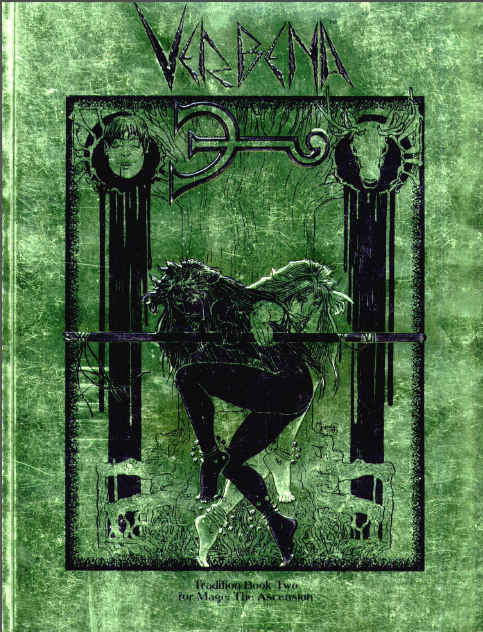
Like I said, the cover is pretty good. The original Tradition Books were some of the best looking paperbacks that White Wolf was putting out at the time. You have some crazy dualist symbolism going on, and a tastefully worn cover. Don’t hold out much hope for the rest of the art.
Unlike the Tribebooks, we head straight to the credits page. There are some really interesting things here that will explain a lot of what went wrong. Our old friend Nicky Rea is back on writing duties, and the author’s special thanks section credits Jackie Cassada as a proofreader, so once again we have a Rea-Cassada co-production. Also on the team were Sam Chupp and Lucien Dark. Chupp was mainly a bit contributor to collaborative projects, and this is Lucien Dark’s only writing credit. This does not inspire confidence.
Also failing to lift my spirits is another curious special thanks credit.
quote:
The Wednesday night gaming group…for playing through the weeks of unAwakened mages without powers, which had so much to do with how this book was written.
Yep! This book is going to follow the adventures of seven completely mundane pagan freaks. Instead of showing us the cool things Verbena can do, we’re just going to hang around with these losers and have people talk at us. Surely, the most engaging part of the Mage setting. You can tell that the Wednesday game was a struggle to get through, both by the tone of the sentence and the fact that the oWoD rules didn’t exactly support mortal PCs, so it really makes you wonder why that experience would be better as a book.
To make things worse, every character you see here is going to be inspired by somebody’s dumb PCs, which means they’re all Mary Sues. All of them. But don’t take my word for it! Let’s meet the cast in the Prelude, Samhain Eve .

The most relatable character of the bunch.
Deborah is introduced to us with her “black hair flying around her face.”
 She’s hanging out with some guys named Thorn, Arion, and Tanith, having a staredown with an old lady. She’s pissed, but then she always is, since she’s a complete psychopath. That’ll become more apparent later, but for now, she was promised “
ultimate power
” (no really) by her weird pagan pals.
She’s hanging out with some guys named Thorn, Arion, and Tanith, having a staredown with an old lady. She’s pissed, but then she always is, since she’s a complete psychopath. That’ll become more apparent later, but for now, she was promised “
ultimate power
” (no really) by her weird pagan pals.
The old lady, named Mother Celene, asks Deborah what she wants out of life. Her answer, that she wants money and power, is deemed too stupid and unimaginative, and so she starts shooting pain beams at her while ranting about how much of Deborah’s vital functions she can perceive. This is meant to convince Deborah to cooperate, I guess.
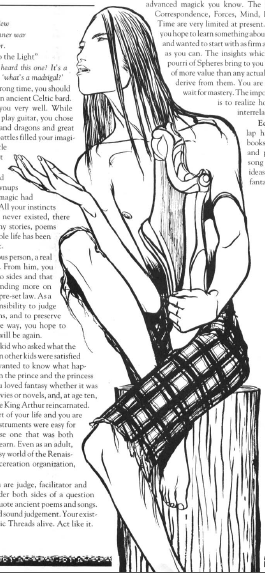
Silver Ladder: the early days
Scene change! This guy is Teague, and he’s a ren faire enthusiast who is really good at the Celtic harp, magically good, in fact. In other words, he’s so good at LARPing that he gets actual magical powers. On top of that, he’s gay, and he has AIDS. He’s introduced getting almost raped on his way to the Ren Faire. He manages to bite one of his aggressors, and they then try to kill him. A wandering banshee shows up to save him by shouting really loudly. Turns out that this banshee had offered Teague the chance to learn real bardic magic, so he accepts. This is the most White Wolf character that has ever been written.
There is one interesting exchange in Teague’s story. Teague tells his banshee friend that he shouldn’t handle his blood, since he has AIDS. The banshee replies that he doesn’t have to have AIDS. It opens up this real philosophical question about power. Obviously, given the choice, any of us would rather not have AIDS, but let’s say that as a wizard, you have the ability to get rid of all AIDS everywhere. It’s not necessarily easy, of course, but you could visit everybody with AIDS and cure them. Would you do it? Or would you choose not to? Of course, the book never explores this, it’s just a cheap throwaway line, but it’s at least a thought provoking one.
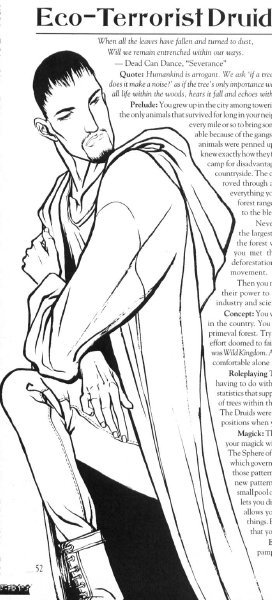
And people say Werewolf's about eco-terrorism.
Next character! By the way, all of these stories are prefaced by an epigraph. I’m not reporting them because they’re all superficial and don’t have anything to do with the plot. This one, though, has Chief Seattle talking about how his tribe feels “the sap of the trees” and all of nature within them. It's a quiet statement of respect, not only for nature, but for humanity itself. The story's about an actual ecoterrorist, named Joe, planning to murder a bunch of workers. He’s the closest we have to a protagonist. He’s out in the woods, rigging spike traps on trees to stab workers, stalling the lumber project. As it turns out, the contractors are there with a security team that literally murders his partner. He runs away, naturally, but is rescued by Jarrol, another mage, who kills the security team. Truly, these are a wise, peace loving people.
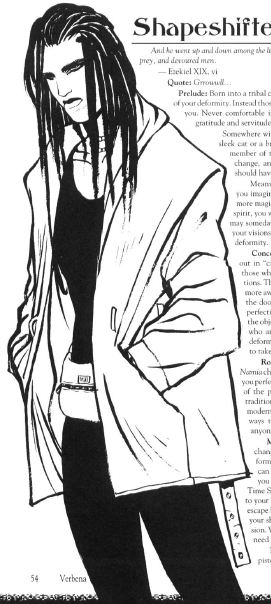
She's just upset that she has to wear a fanny pack.
Our next character is Kamaria, adopted into a monastery from her African village. No other geographical details than that, mind you, she’s from a tribal African village. This village hates and fears people with deformities, and because Kamaria was born a humpback, the monastery had to take her in. Even though they treat her with great love and care, Kamaria can tell they hate her. It’s possible this is nuanced characterization, since Kamaria has horrible self-esteem, but it could also dumb anti-church nonsense. I’ll reserve judgment.
A mentor shows up for Kamaria as she’s gazing into a pool, wishing she could shapeshift into something more beautiful. The two talk a bit about the moon. (Kamaria makes a “Halloween wish” to her “Sister, Moon”. I don’t know if that’s a thing, but I’m guessing not.) Then they leave. She’ll be more developed later, since she’s our love interest. Every splat book needs a good love interest, said nobody ever.
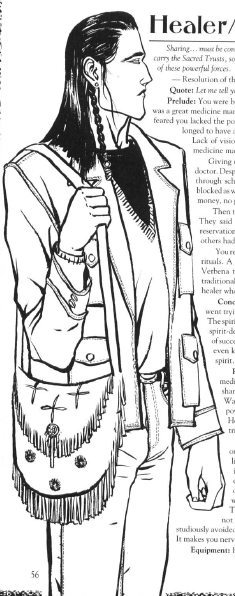
Tragically, he can heal everything except for his own eyes.
Next up is Takoda, a Native American. No tribe, he’s just Native American. That aside, this is probably one of the best of these snippets. It’s probably written by Rea and Cassada, since their entire milieu is about Native American mysticism and issues. This one trends more to the “issues” side, and it gives a great rundown about how all the tourists visiting the tribe are appropriating native culture and cheapening it in the process. It’s basic, but at least he’s not killing anybody or getting raped for the crime of having AIDS. In any case, Takoda was training to become a shaman, but he couldn’t get any visions, so he took up medicine, which is actually kind of interesting. He witnesses a car accident, and helps someone he took to be a tourist save the people inside. She promises to teach him magic, and she accepts. The story’s alright, but Takoda’s dialogue in the book proper is one of the worst things about it, so it’s dragged down.
The next story brings us another relevant epigraph.
quote:
God is alive. Magic is afoot
-Buffy St. Claire
Magic is alive. The Goddess is afoot
-several thousand Goddess worshippers
But it doesn’t bode well. The story itself is about a sheltered Christian girl named Aileen. Her friend was raped and murdered, and she’s feeling sad about it. She doesn’t think her family is though, and that upsets her. In fact, she’s beginning to doubt the existence of a loving God! She wanders around a little bit, and she accidentally joins a Wiccan celebration, as you do. Stargazer (yes), the priestess, invites her to come back some time, and Aileen thinks about it.
On the way home, though, she sees a suspicious looking guy on the road, so she does the logical thing for someone who knew someone who was kidnapped and accepts a ride from a complete stranger. Turns out this guy killed her friend! Who woulda thunk it? Ironically, she trusted the guy because he had braces, but later remembered that literally the only distinguishing clue the police found regarding her friend’s murderer was that he wore braces.
To escape, she bites off the guy’s hand.
 The story is redeemed. She runs home, bursting in on her parents during a get-together, and goes to the bathroom. Her mother chases her down and yells at her for having embarrassed him and looking like a lunatic. Obviously, this isn’t okay, but I would be freaked out too if my daughter came home looking like she had eaten someone. She decides that she’s going to own her Lunatic label, and become Moon Knight! Or a Wiccan, that works too.
The story is redeemed. She runs home, bursting in on her parents during a get-together, and goes to the bathroom. Her mother chases her down and yells at her for having embarrassed him and looking like a lunatic. Obviously, this isn’t okay, but I would be freaked out too if my daughter came home looking like she had eaten someone. She decides that she’s going to own her Lunatic label, and become Moon Knight! Or a Wiccan, that works too.
Next time : You wake up in a dark room. You’re bound, gagged, and naked. What do you do?